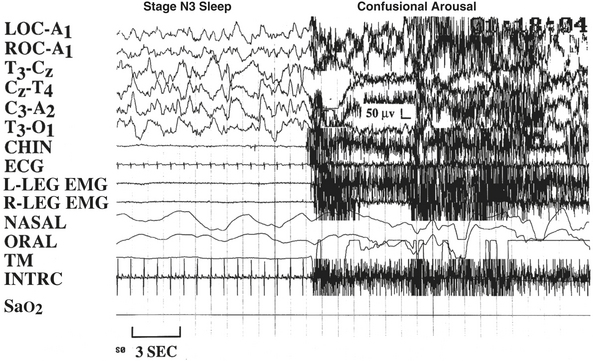Vignette 5
Confusional Arousals
A 45-year-old woman with significant psychosocial stresses presented with arousals from sleep in confusion and panic.1,2 A polysomnogram captured one of her typical spells. This event occurred suddenly as she sat up during stage N3 sleep (Vignette Fig. 5.1). The split-screen video analysis demonstrated her frightened and confused countenance. The confusional arousal occurred abruptly out of stage N3 sleep with no obvious acute precipitators. It was associated with more violent and emotive elements than might otherwise routinely be expected to occur with a child during a confusional arousal. In addition, the event occurs early in the morning (4:32 AM), whereas confusional arousals in children classically occur early in the night during the first or second period of N3 sleep. The patient’s confusion slowly improved during the technician’s stream of questions until she returned to her baseline waking level of cognitive functioning. When the technician asked, “What were you thinking about?” the patient reported some vaguely described mental imagery, but when asked, “Were you having a dream?” the patient replied, “I don’t remember a dream.” If this event had occurred in association with rapid eye movement (REM) sleep and the patient had reported a well-structured and frightening dream, this spell might have been considered a mild nightmare.

VIGNETTE FIGURE 5.1 The polysomnogram of a 45-year-old woman with a history of confusional arousals and panic shows the classic association with stage N3 sleep. LOC, Left outer canthus; ROC, right outer canthus; A1, left ear; T, temporal; C, central; O, occipital; ECG, electrocardiogram; L-LEG, left leg; R-LEG, right leg; EMG, electromyogram; TM, thoracic movement; INTRC, intercostal EMG; Sao2, arterial oxygen saturation. (Modified from Dyken ME, Yamada T, Lin-Dyken DC. Polysomnographic assessment of spells in sleep: nocturnal seizures versus parasomnias. Semin Neurol. 2001;21:377-390.)








